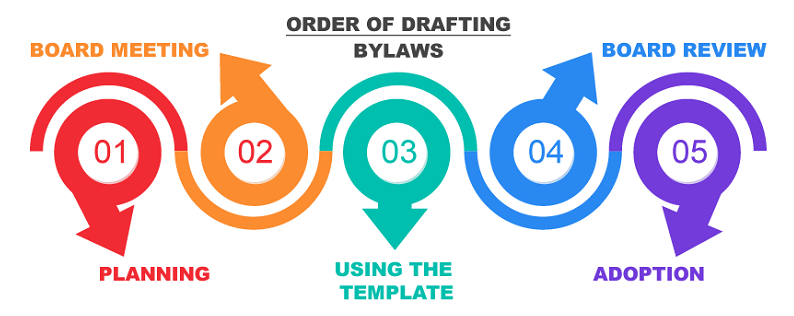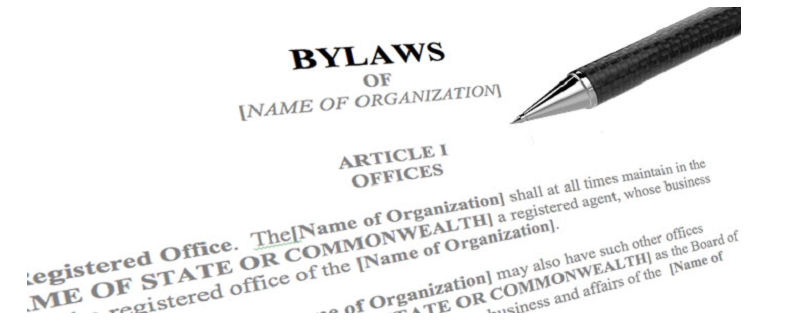
Whether you’re just getting your business off the ground or seeking to formalize the internal structure of an existing company, establishing bylaws is a crucial step for any C-corporation. These foundational documents will govern your corporation’s internal affairs, including key operational details, from the responsibilities of your board of directors to the scheduling of shareholder meetings. Despite their importance, bylaws can often be overlooked or hastily assembled, which can lead to future conflicts or compliance issues.
Contents
- Understanding the Role of Bylaws in C-Corporations
- Key Components of Effective C-Corporation Bylaws
- Identifying Information: Name, Place of Business, and Purpose
- Board of Directors: Structure, Duties, and Procedures
- Officers: Roles, Responsibilities, and Selection
- Shareholder Meetings: Schedules, Notice, and Voting Rights
- Stock: Classes, Issuance, and Transfer
- Committees: Establishment and Responsibilities
- Amendments: Procedures for Changing Bylaws
- Dispute Resolution: Methods for Resolving Internal Conflicts
- Establishing Bylaws for Your C-Corporation: A Step-By-Step Guide
- Common Mistakes to Avoid When Establishing C-Corporation Bylaws
- References
Understanding the Role of Bylaws in C-Corporations
Before getting into the details of how to establish bylaws for your C-corporation, it’s important to understand the role of bylaws in the first place. Bylaws, along with the articles of incorporation, form the foundational legal documents for any corporation. They set the rules for how the company is governed and operated.
Definition and Purpose of Bylaws
Bylaws are an internal document that governs the day-to-day operations of a corporation. They lay out the procedures for important aspects of corporate governance, including electing directors, holding meetings, issuing stock, and more. The goal of bylaws is to ensure that the corporation runs smoothly and effectively, while also providing a clear process for resolving any potential disputes or conflicts.
The Legal Requirement of Bylaws
In most jurisdictions, C-corporations are legally required to have bylaws. While the specific requirements may vary, they generally need to be adopted by the corporation’s board of directors at their first meeting. This is a crucial legal step that can impact everything from your corporation’s liability to its tax status. Failing to adopt bylaws can lead to a variety of legal and operational issues down the road, so it’s not something to be taken lightly.
How Bylaws Differ from Articles of Incorporation
Bylaws are often confused with the articles of incorporation, but they serve different purposes. The articles of incorporation are a public document filed with the state to legally form the corporation. They typically include basic information about the corporation, such as its name, registered agent, and initial directors.
On the other hand, bylaws are more comprehensive and detailed. They are not usually filed with the state and are not generally available to the public. Instead, they serve as an internal handbook guiding the corporation’s operations and governance. While the articles of incorporation can be thought of as the corporation’s birth certificate, the bylaws function more like its constitution, providing a detailed framework for its governance and operation [1].

Key Components of Effective C-Corporation Bylaws
Now that we have a clear understanding of the role of bylaws in C-corporations, it’s time to explore the key components that should be included in these crucial documents. Effective bylaws should be comprehensive, covering all aspects of the corporation’s operations, from the board of directors to shareholder meetings, and beyond.
Identifying Information: Name, Place of Business, and Purpose
The first section of your bylaws should contain basic identifying information about the corporation. This includes the full legal name of the corporation, its place of business, and its corporate purpose. The corporate purpose doesn’t need to be extremely specific; a general statement such as “to engage in any lawful activity” is typically sufficient.
Board of Directors: Structure, Duties, and Procedures
The bylaws should clearly outline the structure of the board of directors. This includes how many directors there will be, how they’re chosen, their terms of office, and how vacancies are filled. The bylaws should also specify the duties and responsibilities of the directors, as well as the procedures for calling and conducting board meetings, including notice requirements and quorum rules.
Officers: Roles, Responsibilities, and Selection
Next, the bylaws should detail the roles, responsibilities, and selection process for corporate officers, including the president, vice-president, secretary, and treasurer. This section should specify who is eligible to be an officer, how they’re elected or appointed, their terms of office, and what their specific duties are. It should also provide procedures for removing officers or filling vacancies.
Shareholder meetings are a crucial part of corporate governance, and your bylaws should set clear procedures for these meetings. This includes when and how often regular meetings are held, how special meetings can be called, and the rules for notice of meetings. The bylaws should also cover shareholder voting rights, including how many votes each shareholder has, and the procedures for voting in person or by proxy [2].
Stock: Classes, Issuance, and Transfer
The bylaws should provide details on the corporation’s stock, including the different classes of stock and their associated rights, how stock is issued, and the procedures for transferring stock. This section should also include any restrictions on the transfer of shares, which can be crucial for maintaining control of the corporation.
Committees: Establishment and Responsibilities
If your corporation plans to have committees, such as an executive committee or an audit committee, the bylaws should set out the rules for establishing these committees and their roles and responsibilities. This includes who can serve on a committee, how committee members are chosen, and what authority the committee has.
Amendments: Procedures for Changing Bylaws
Given that corporations evolve over time, it’s important that your bylaws include procedures for making amendments. This section should specify who has the power to amend the bylaws, what vote is required to make amendments, and any requirements for notice of proposed amendments.
Dispute Resolution: Methods for Resolving Internal Conflicts
Lastly, effective bylaws should include a provision for resolving internal disputes. This might include a requirement for mediation or arbitration, or specific procedures for resolving disputes among directors, officers, or shareholders. Including this provision can help avoid costly and time-consuming litigation down the road.

Establishing Bylaws for Your C-Corporation: A Step-By-Step Guide
After gaining a comprehensive understanding of what your bylaws should encompass, the next logical step is putting all this theory into practice. To make the process more manageable, we’ve broken down the task into a series of steps. Here’s a step-by-step guide to help you establish effective bylaws for your C-corporation.
Gathering the Necessary Information
The first step in establishing your bylaws is to gather all the necessary information. This includes basic information about your corporation, such as its legal name and place of business, as well as more detailed information about its governance structure. You’ll need to decide on the size and structure of your board of directors, the roles and responsibilities of your corporate officers, and the rules for shareholder meetings and voting rights [3].
Drafting the Bylaws
Once you’ve gathered all the necessary information, you can begin drafting your bylaws. Start by creating an outline based on the key components we discussed earlier, and then fill in each section with your corporation’s specific information.
Remember, bylaws are a legal document, and the language used should be precise and unambiguous. If you’re uncertain about how to word certain sections, you may want to look at sample bylaws or consult with a lawyer.
Reviewing Bylaws with Legal Counsel
Even if you feel comfortable drafting your bylaws, it’s still a good idea to have them reviewed by a lawyer. This ensures that your bylaws are legally sound and compliant with all relevant laws and regulations. It can also help you avoid potential legal issues down the road.
Adopting the Bylaws in the Initial Directors Meeting
Once your bylaws have been drafted and reviewed, they must be formally adopted by the corporation’s board of directors. This typically happens at the board’s first meeting. The adoption of the bylaws should be documented in the meeting minutes, and each director should receive a copy of the adopted bylaws.
Documenting and Storing the Bylaws
Finally, once your bylaws have been adopted, they should be signed by the corporation’s officers and kept in a safe place. They should also be readily accessible to all directors, officers, and shareholders [4].
Remember, the bylaws are a living document, which means they should be reviewed regularly and updated as necessary to reflect changes in your corporation’s structure or operations, or changes in the law.

Common Mistakes to Avoid When Establishing C-Corporation Bylaws
Creating bylaws is an essential process that demands a great deal of thought and attention. Even with the best intentions, mistakes can occur that might later cause issues in corporate governance or even legal complications. Here are some of the most common mistakes to avoid when establishing your C-corporation bylaws.
Overlooking State Laws
Each state has its own laws and regulations governing corporations and their bylaws. A common mistake is to overlook these laws when drafting your bylaws. To avoid this, make sure to familiarize yourself with your state’s corporate laws or consult with a lawyer who specializes in corporate law in your state.
Being Too Specific or Too Vague
Your bylaws should be detailed enough to provide clear guidance, but not so specific that they become restrictive. Conversely, if your bylaws are too vague, they may not provide enough guidance, leading to confusion and potential disputes. Striking the right balance can be tricky, but it’s crucial for effective corporate governance.
Ignoring Potential Conflicts and Disputes
It’s not pleasant to think about potential conflicts or disputes, but it’s crucial to do so when drafting your bylaws. Your bylaws should include clear procedures for resolving any potential internal conflicts. Without these procedures, disputes can become costly and time-consuming, and can even threaten the stability of your corporation [5].
Failing to Allow for Future Amendments
Corporations evolve over time, and your bylaws need to be able to evolve with them. Failing to include a provision for amending the bylaws is a common mistake that can lead to difficulties down the road. Make sure your bylaws include a clear process for making amendments as necessary.
Not Reviewing Bylaws Regularly
Even after your bylaws have been established, your job isn’t done. It’s important to review your bylaws regularly and make amendments as necessary. This not only ensures that your bylaws stay up-to-date, but also helps keep them top-of-mind for your board of directors, officers, and shareholders.
References
[1] Forming a Corporation
[2] 6 Steps to Becoming a Corporation
[3] How to Operate a C Corporation
[4] Drafting Corporate Bylaws
[5] Bylaws Corporation Filling
